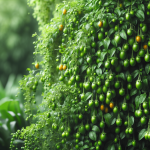This post may contain affiliate links. As an Amazon Associate, we may earn commissions from qualifying purchases.
Allelopathy is a fascinating natural phenomenon where certain plants release chemicals to suppress the growth of nearby vegetation, making it a powerful tool for gardeners like you. By understanding and utilizing allelopathic plants in your garden, you can effectively practice companion planting and control weeds without relying on synthetic herbicides. This article explores how you can harness the power of allelopathy to create a healthier, more harmonious garden ecosystem that thrives naturally. Dive in to discover the secrets of these remarkable plants and how to turn this eco-friendly strategy to your gardening advantage. Have you ever found yourself wishing for an easier way to manage weeds and optimize plant growth in your garden? If so, you’re not alone. Many gardeners are constantly searching for effective ways to achieve these goals. One powerful yet often overlooked strategy is the use of allelopathy.
What Is Allelopathy?
Allelopathy is a biological phenomenon where plants release chemicals (allelochemicals) into the environment, which can have positive or negative effects on nearby plants. This process can influence germination, growth, survival, and reproduction of neighboring plants. While some plants use allelopathy to inhibit competition (i.e., weed control), others may enhance the growth of surrounding plants, creating symbiotic relationships.
The Science Behind Allelopathy
Allelochemicals are natural compounds produced by plants and released through various means such as root exudation, leaf litter, volatilization from leaves, and even through microbial interactions in the soil. These chemicals can alter the soil’s microbial community, nutrient cycling processes, and even the physiological functions of plants around them.
Benefits of Allelopathic Plants in Gardening
Utilizing allelopathic plants in your garden offers numerous benefits. Let’s delve into how these plants can be beneficial for both companion planting and weed control.
Natural Weed Control
One of the most effective uses of allelopathic plants is in natural weed control. Certain plants release chemicals that inhibit the germination or growth of weeds, reducing the need for herbicides and manual weeding. For instance, the black walnut tree produces juglone, a potent allelochemical that can suppress a wide range of plant species.
Enhanced Plant Growth
Allelopathic plants can also enhance the growth of their neighboring plants by reducing competition and sometimes providing beneficial compounds that promote growth. For example, cover crops like rye and clover are known to improve the soil health, which in turn benefits the plants grown alongside them.
Soil Health Improvement
Using allelopathic plants can also contribute to overall soil health. Some allelochemicals can stimulate microbial activity, improve nutrient cycling, and even act as organic pesticides by deterring harmful soil organisms.

Types of Allelopathic Plants
Understanding which plants are allelopathic and how to use them effectively can be a game-changer for your garden. Here’s a breakdown of some common allelopathic plants and their uses.
Trees and Shrubs
- Black Walnut (Juglans nigra): Produces juglone, a chemical that can be toxic to many plants including tomatoes, potatoes, and roses.
- Eucalyptus (Eucalyptus spp.): Releases volatile oils that can inhibit seed germination of nearby plants.
- Pine (Pinus spp.): Conifer needles release compounds that can acidify and reduce competition in their root zone.
Grasses and Cover Crops
- Rye (Secale cereale): Its root exudates contain allelochemicals that are effective against broadleaf weeds.
- Oats (Avena sativa): Known to suppress weeds and provide a good ground cover.
- Clover (Trifolium spp.): Improve soil nitrogen levels and can suppress weed growth.
Flowers and Herbs
- Sunflower (Helianthus annuus): Produces allelochemicals that can inhibit the growth of nearby weeds.
- Garlic (Allium sativum): Its root secretions can deter various soil-borne pathogens.
- Mint (Mentha spp.): Releases compounds that can suppress the growth of certain weeds.
| Category | Examples | Allelochemicals | Primary Effects |
|---|---|---|---|
| Trees & Shrubs | Black Walnut, Eucalyptus | Juglone, Volatile oils | Inhibits seed germination, toxic to certain plants |
| Grasses | Rye, Oats | Various root exudates | Weed suppression, ground cover |
| Flowers & Herbs | Sunflower, Garlic, Mint | Various compounds | Weed suppression, pest deterrence |
How to Utilize Allelopathic Plants in Companion Planting
Companion planting with allelopathic plants requires some planning and understanding of plant interactions. Let’s explore some tips and strategies to effectively use these plants in your garden.
Planning Your Garden Layout
When planning your garden layout, consider both the beneficial and adverse effects of allelopathic plants. For example, place allelopathic plants that inhibit weed growth near weed-prone areas. Keep plants known to be susceptible to allelochemicals away from strong allelopathic species.
Rotational Planting
Incorporate allelopathic cover crops into your crop rotation schedule. For instance, planting rye in the offseason can help suppress weed growth and improve soil health, preparing the plot for the next planting season.
Strategic Plant Pairing
Pair plants that benefit from each other’s allelochemicals. For example, planting garlic amongst rose bushes can help deter pests, enhancing the growth and health of roses.
Mulching and Leaf Litter Management
Utilize the leaf litter from allelopathic trees and shrubs as mulch to suppress weeds. However, ensure that the allelochemicals in the mulch are not harmful to desired plants in your garden.

Case Studies: Successful Use of Allelopathic Plants
Case Study 1: Black Walnut and Vegetable Gardens
A gardener faced persistent weed issues in his vegetable garden. By planting black walnut trees around the perimeter, the juglone effectively suppressed weeds without affecting the vegetable crops, which were planted at a safe distance from the drip line of the trees.
Case Study 2: Rye in Organic Farms
An organic farmer struggled with weed infestation. Incorporating rye as a cover crop in the offseason not only suppressed weeds but also enhanced soil organic matter. The subsequent crop yields improved noticeably.
Case Study 3: Sunflower and Weed Control
A community garden utilized sunflower plants to naturally control coast live oak weeds. The sunflower’s allelochemicals suppressed the weed growth, reducing the need for manual weeding and herbicides.
Potential Challenges and Solutions
While allelopathy offers several benefits, there are challenges you might encounter. Here are some common issues and their solutions:
Unintended Plant Damage
Certain allelopathic plants might harm desirable plants. Always research the compatibility between plants before incorporating allelopathic species into your garden.
Solution: Conduct small-scale trials with allelopathic plants and observe interactions before full-scale implementation.
Soil and Water Contamination
Allelochemicals can accumulate in the soil or water, affecting both the present plants and future crops.
Solution: Rotate allelopathic plants with those that can degrade the allelochemicals and restore soil balance.
Plant Stress and Limited Growth
Some plants, especially young seedlings, might experience stress due to the allelochemicals in the soil.
Solution: Provide adequate irrigation, nutrients, and aeration to support plant growth and alleviate stress.
Best Practices for Gardeners
To make the most of allelopathic plants, follow these best practices:
Research and Plan
Invest time in researching which allelopathic plants are suitable for your garden. Consider soil type, climate, and existing plant species.
Start Small
Implement allelopathic plants in small sections of your garden initially. Monitor the interactions and effects before expanding their use.
Use Complementary Plants
Pair allelopathic plants with those that can benefit from their presence. Studies have shown that diverse plantings often yield better results.
Regular Monitoring
Consistently monitor your garden to understand how allelopathic plants impact the overall ecosystem. Adjust your planting strategies as needed for optimal results.
Conclusion
Allelopathy provides an exciting, environmentally friendly avenue for gardeners to explore companion planting and natural weed control. By understanding the principles of allelopathy and practicing careful planning, you can leverage these unique plant interactions to create a thriving, sustainable garden. Happy planting!








